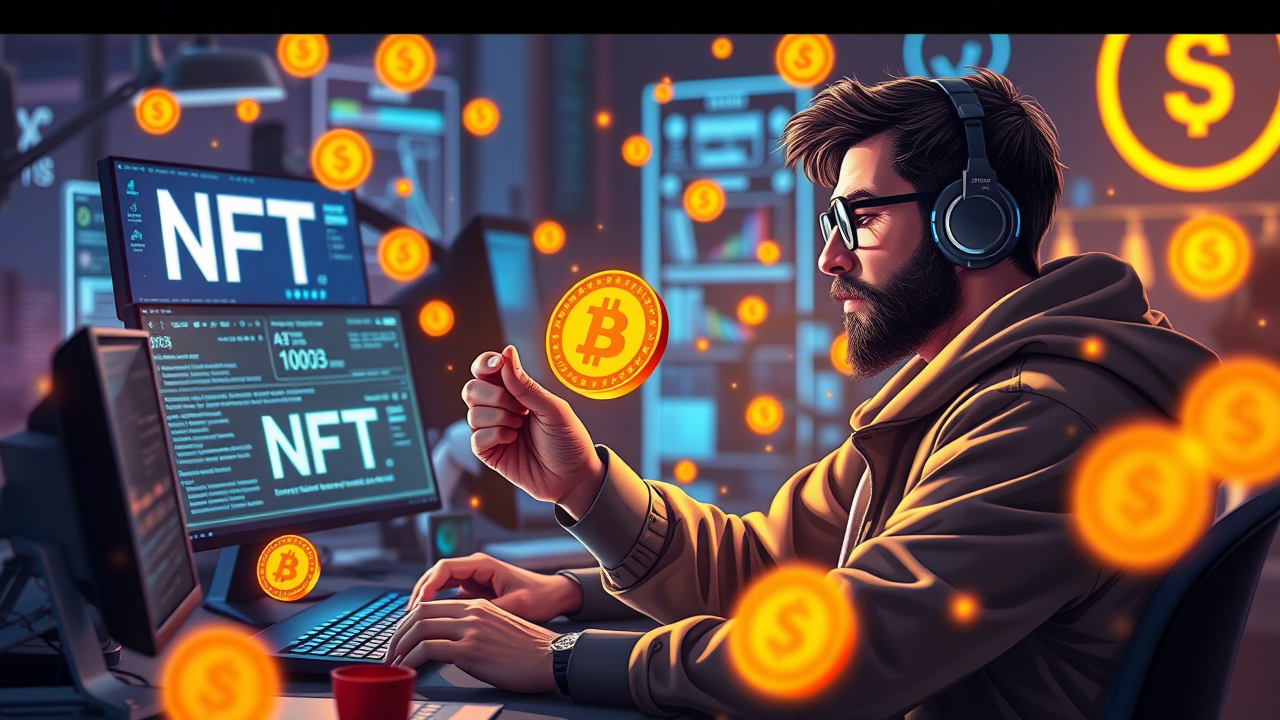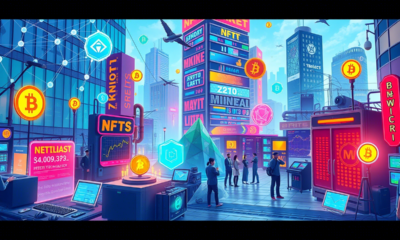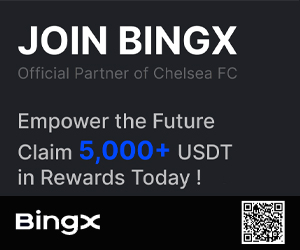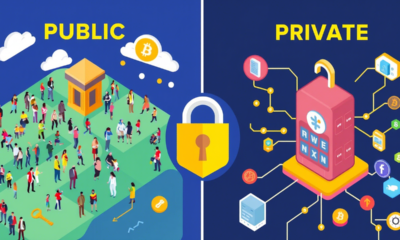NFTs & Digital Art
Exploring Soulbound Tokens and Their Applications

|
Getting your Trinity Audio player ready...
|

Exploring Soulbound Tokens and Their Applications: A Technical Deep Dive
Introduction
In the rapidly evolving landscape of blockchain technology, soulbound tokens (SBTs) have emerged as a revolutionary concept. These tokens represent a digital asset that is unique to an individual, tied to their identity, and cannot be transferred. First proposed by Ethereum co-founder Vitalik Buterin, economist Glen Weyl, and lawyer Puja Ohlhaver in their May 2022 paper “Decentralized Society: Finding Web3’s Soul”, SBTs represent a fundamental shift in how we conceptualize digital ownership and identity. As we delve into exploring soulbound tokens and their applications, we’ll uncover their technical underpinnings, cryptographic significance, potential use cases, and the implications they may have on the future of online interactions.
Technical Foundations of Soulbound Tokens
Smart Contract Architecture
Soulbound tokens are implemented through specialized smart contracts that fundamentally alter the traditional ERC-721 or ERC-1155 NFT standards. These modifications include:
- Transfer Function Removal: The core
transferandtransferFromfunctions are either removed entirely or modified to throw exceptions when called. - Access Control Mechanisms: Permissioning systems that restrict token minting capabilities to authorized entities while maintaining transparency.
- On-chain Verification Logic: Cryptographic verification methods that validate credentials without revealing sensitive information.
Sample code for a basic SBT contract implementation:
// SPDX-License-Identifier: MIT
pragma solidity ^0.8.0;
import "@openzeppelin/contracts/token/ERC721/ERC721.sol";
import "@openzeppelin/contracts/access/Ownable.sol";
contract SoulboundToken is ERC721, Ownable {
constructor(string memory name, string memory symbol) ERC721(name, symbol) {}
function mint(address to, uint256 tokenId) external onlyOwner {
_safeMint(to, tokenId);
}
// Override transfer functions to make tokens soulbound
function _beforeTokenTransfer(
address from,
address to,
uint256 tokenId,
uint256 batchSize
) internal override {
require(from == address(0) || to == address(0), "Token transfer is not allowed");
super._beforeTokenTransfer(from, to, tokenId, batchSize);
}
// Disable approval functions
function approve(address, uint256) public override {
revert("Approval not supported for soulbound tokens");
}
function setApprovalForAll(address, bool) public override {
revert("Approval not supported for soulbound tokens");
}
}
Cryptographic Identity Binding
The binding of SBTs to specific identities involves advanced cryptographic techniques:
- Zero-Knowledge Proofs (ZKPs): Allow verification of information without revealing the underlying data, critical for privacy-preserving SBTs.
- Hierarchical Deterministic (HD) Derivation Paths: Enable the connection between a user’s wallet and their various soulbound tokens while maintaining cryptographic security.
- Threshold Signatures: Can be implemented to require multiple parties to authorize certain operations, enhancing security and trust.
Soul Architecture: The Technical Framework
Beyond individual tokens, SBTs exist within a broader technical framework often referred to as “Soul Architecture.” This includes:
Soul Wallets
Soul wallets represent the cryptographic boundary of an individual’s digital personhood. Unlike conventional cryptocurrency wallets focused on asset storage, soul wallets are designed to:
- Manage multiple credentials across various domains
- Support social recovery mechanisms through “guardians”
- Implement programmable disclosure policies
- Maintain cryptographic links to institutional issuers
Issuers and Verifiers
The SBT ecosystem introduces specialized roles with distinct technical requirements:
- Issuers: Entities with cryptographic authority to mint SBTs to soul wallets, such as universities, employers, or certification authorities.
- Verifiers: Systems that cryptographically validate the authenticity of SBTs without requiring direct communication with issuers.
- Attestation Frameworks: Technical standards that define how attributes and claims are encoded, signed, and verified across the ecosystem.
Advanced Cryptographic Properties
SBTs implement several novel cryptographic properties not typically found in transferable tokens:
- Non-Collateralizability: Technical measures prevent the tokens from being used as collateral in financial protocols.
- Revocation Mechanisms: Cryptographic methods allow issuers to invalidate tokens when necessary while maintaining an immutable record of both issuance and revocation.
- Temporal Validity: Time-bound cryptographic constraints that can make tokens expire or evolve in properties over time.
What are Soulbound Tokens?
Soulbound tokens are a novel form of non-fungible token (NFT) that cannot be traded or transferred between users. The term “soulbound” draws inspiration from the MMORPGs (Massively Multiplayer Online Role-Playing Games) where certain items are linked to a player’s character, reflecting their identity and achievements. Unlike traditional NFTs, which can be bought and sold, SBTs are tied directly to a person, creating a permanent record of their values, accomplishments, and affiliations.
Technical Comparison with Traditional NFTs
| Feature | Traditional NFTs | Soulbound Tokens |
|---|---|---|
| Transfer Capability | Can be freely transferred | Non-transferable |
| Smart Contract Standard | Usually ERC-721 or ERC-1155 | Modified ERC-721/1155 or new standards like ERC-5114 |
| Value Proposition | Primarily financial/collectible | Identity, reputation, credentials |
| Metadata Mutability | Typically immutable | May support controlled updates |
| Privacy Features | Limited | Can incorporate zero-knowledge proofs |
| Recovery Mechanisms | Limited to wallet recovery | May include social recovery options |
Key Characteristics of Soulbound Tokens
- Non-transferable: Once assigned, these tokens remain with the individual indefinitely.
- Identity representation: They often reflect personal achievements, credentials, or affiliations.
- Programmable: Built on blockchain technology, they can be programmed with specific functions and privileges.
- Composable: Multiple SBTs can interact to create compound credentials or permissions.
- Selectively disclosable: Advanced implementations allow users to reveal specific attributes without exposing the entire credential.
Technical Implementation Approaches
Several technical approaches to SBT implementation have emerged:
1. Smart Contract Modification
This approach modifies existing NFT standards by overriding transfer functions:
function transferFrom(address from, address to, uint256 tokenId) public override {
revert("SoulboundToken: transfer is not allowed");
}
2. ERC-5114: Soulbound Token Standard
A proposed Ethereum standard specifically designed for non-transferable tokens with built-in verification mechanisms:
interface IERC5114 {
event Attest(address indexed issuer, address indexed soul, uint256 tokenId);
event Revoke(address indexed issuer, address indexed soul, uint256 tokenId);
function attest(address soul, uint256 tokenId) external;
function revoke(address soul, uint256 tokenId) external;
function isSoulbound(uint256 tokenId) external view returns (bool);
}
3. Account Abstraction Approaches
Leveraging Ethereum’s EIP-4337 and similar proposals to implement account-level restrictions on token movements:
function isValidOperation(
UserOperation calldata userOp,
bytes32 userOpHash
) external view returns (uint256 validationData) {
// Prevent operations that attempt to transfer soulbound tokens
if (isSoulboundTransferAttempt(userOp)) {
return VALIDATION_FAILED;
}
return VALIDATION_SUCCESS;
}
The Importance of Soulbound Tokens
Exploring soulbound tokens and their applications becomes crucial when considering their potential impact on various industries. Here are some essential aspects to understand about their importance:
Identity Verification and Self-Sovereign Identity
In a world increasingly focused on privacy and data security, SBTs offer a reliable method for identity verification. By linking a person’s credentials and achievements to an immutable digital token, organizations can simplify the process of verifying identities without the need for extensive background checks.
From a technical perspective, SBTs enable:
- Selective Disclosure: Users can cryptographically prove specific attributes (age verification, accreditation, etc.) without revealing unrelated personal information.
- Correlation Resistance: Well-designed SBT systems prevent tracking across different services even when the same credentials are used.
- Decentralized Identifiers (DIDs): SBTs can integrate with W3C DID specifications to create interoperable identity solutions.
Reputation Systems and Sybil Resistance
SBTs can serve as the foundation for decentralized reputation systems. By accumulating soulbound tokens linked to personal accomplishments and endorsements, individuals can build an online reputation that is more resilient to manipulation and fraud.
Technical implementations include:
- Quadratic Voting: When combined with SBTs, quadratic voting mechanisms can help prevent Sybil attacks (where one person creates multiple identities) in governance systems.
- Reputation Scoring Algorithms: On-chain algorithms that weigh different SBTs based on issuer credibility, age, and relevance to generate context-specific reputation scores.
- Proof-of-Personhood: SBTs can strengthen systems requiring unique human verification, with cryptographic guarantees against duplicate identities.
Composable Trust Networks
One of the most powerful technical aspects of SBTs is their ability to form composable trust networks:
- Trust Graphs: SBTs create verifiable connections between souls (identities), institutions, and communities.
- Intersection Verification: Systems can verify properties that emerge from the intersection of multiple SBTs without revealing the SBTs themselves.
- Recursive Issuance: SBTs can be issued based on combinations of other SBTs, creating complex credential hierarchies.
Applications of Soulbound Tokens
As blockchain technology continues to progress, the potential applications of soulbound tokens are diverse and far-reaching. Here, we explore key areas where SBTs can be integrated effectively with their technical implementations.
1. Education and Certification
Educational institutions can issue SBTs to graduates that verify their achievements, degrees, and certifications. These tokens would be tamper-proof, providing employers with a straightforward way to validate a candidate’s qualifications.
Technical implementation considerations:
- Verifiable Credentials Format: Alignment with W3C Verifiable Credentials Data Model for interoperability.
- Metadata Standards: Standardized schemas for educational achievements that include course details, grades, competencies, and accreditation information.
- Cross-Institution Verification: Technical protocols for verifying credentials across different educational institutions and platforms.
Example projects:
- Masa Finance – Building SBT infrastructure for education credentials
- Galxe – Credentials network with educational attestations
2. Professional Credentials and Labor Markets
In professional environments, SBTs can help showcase credentials and expertise while transforming labor markets:
- Skills-Based Matching Algorithms: Technical systems that match job requirements with credential SBTs while preserving privacy.
- On-Chain References: Former employers can issue performance SBTs that serve as tamper-proof references.
- Continuous Verification: Automated systems to verify the ongoing validity of professional credentials.
Technical frameworks:
- POAP (Proof of Attendance Protocol): While not strictly soulbound, POAP’s architecture has influenced professional credential SBTs.
- EAS (Ethereum Attestation Service): A general-purpose attestation protocol that can issue professional credentials as SBTs.
3. Blockchain-Based Voting and Governance
Soulbound tokens could revolutionize voting systems by ensuring that a person’s vote is uniquely tied to their identity:
- Quadratic Voting Implementation: Technical mechanisms for weighting votes based on the number and diversity of a person’s SBTs.
- Confidence-Weighted Governance: Algorithms that weigh votes based on relevant experience SBTs.
- Delegated Voting Mechanisms: Technical frameworks for delegating voting power without transferring SBTs.
4. DeFi and Uncollateralized Lending
Perhaps one of the most transformative applications is in decentralized finance:
- Reputation-Based Credit Scoring: Algorithms that analyze a person’s SBTs to determine creditworthiness without traditional credit checks.
- Social Recovery for DeFi: Technical frameworks for recovering assets using trusted guardians verified through SBTs.
- Uncollateralized Lending Pools: Smart contracts that assess lending risk based on reputation SBTs rather than collateral.
Technical implementations:
- RociFi: Developing on-chain credit scoring using reputation tokens
- Gitcoin Passport: Using SBT-like attestations for Sybil resistance in funding allocation
5. Social Networks and Content Provenance
SBTs can transform how we interact online:
- Reputation-Based Access Control: Technical systems that grant permissions based on combinations of SBTs.
- Content Provenance: Cryptographic proofs that tie content to the original creator through SBTs.
- Algorithmic Content Curation: Recommendation systems that use SBTs to filter content and reduce spam.
Technical Challenges and Considerations
While the potential of soulbound tokens is vast, there are significant technical challenges to address:
Privacy and Selective Disclosure
- Zero-Knowledge Implementation Complexity: ZK proofs add substantial computational overhead but are essential for privacy.
- Metadata Leakage: Even with ZK systems, metadata analysis can sometimes deanonymize users.
- Technical Solutions: Projects like Semaphore and Aztec Network are developing privacy primitives applicable to SBTs.
Recovery Mechanisms
The permanent nature of SBTs introduces significant technical challenges:
- Social Recovery Protocols: Technical standards for designating trusted contacts who can help recover access.
- Progressive Security Models: Systems that increase security requirements based on the importance of the SBTs.
- Multi-Party Computation (MPC): Cryptographic techniques that split sensitive keys across multiple parties for added security.
Standardization and Interoperability
For SBTs to reach their potential, technical standards are crucial:
- Cross-Chain Recognition: Technical protocols for verifying SBTs issued on different blockchains.
- Metadata Schemas: Standardized formats for representing different types of credentials and achievements.
- Revocation Standards: Unified approaches to handling credential revocation without undermining immutability.
Regulatory Compliance
Technical implementations must address:
- Data Portability Requirements: Mechanisms to comply with regulations like GDPR’s right to data portability.
- Pseudonymity vs. Identification: Technical solutions that balance privacy with legitimate verification needs.
- Right to be Forgotten: Technical approaches to credential expiry or nullification while maintaining system integrity.
Future Directions: The Path to a Decentralized Society
The SBT ecosystem continues to evolve with several key technical developments on the horizon:
Pluralistic SBT Networks
Rather than a single dominating SBT framework, technical development is moving toward pluralistic networks where multiple SBT systems interoperate through:
- Cross-Framework Verification Standards: Technical protocols for verifying SBTs across different implementations.
- Decentralized Identity Hubs: Systems that aggregate and manage SBTs from various issuers and chains.
- Metadata Translation Layers: Technical bridges that convert between different SBT standards.
Soul-Binding Beyond Blockchain
While blockchain provides a natural foundation for SBTs, the concept is expanding to other technologies:
- TEE (Trusted Execution Environments): Using secure enclaves for privacy-preserving SBT verification.
- Self-Sovereign Identity Integration: Combining SBTs with broader SSI frameworks like Hyperledger Indy.
- Offline Verification Protocols: Technical methods for verifying SBTs without internet connectivity.
Governance and Evolution
The governance of SBT standards themselves represents a significant technical challenge:
- Meta-Governance SBTs: Tokens that represent the right to participate in SBT standard governance.
- Algorithmic Standard Evolution: Technical frameworks for updating standards based on usage patterns and needs.
- Governance Minimization: Technical approaches to reducing governance requirements while maintaining system flexibility.
Conclusion
Exploring soulbound tokens and their applications reveals an exciting frontier at the intersection of blockchain technology and personal identity. As the digital landscape continues to evolve, SBTs promise to enhance security, streamline identity verification, and revolutionize interactions in various domains.
By understanding both the technical capabilities and challenges associated with soulbound tokens, individuals and organizations can better prepare for the future of digital identity. It’s essential to stay informed about this emerging concept, considering its implications for personal privacy and online trust.
The development of soulbound tokens represents not just a technical evolution in blockchain technology, but potentially a fundamental shift in how we conceptualize digital identity, reputation, and social coordination. As the technical frameworks mature and standards emerge, SBTs may become a cornerstone of what Buterin, Weyl, and Ohlhaver call a truly “decentralized society.”
Resources and Further Reading
- Decentralized Society: Finding Web3’s Soul – The original paper by Buterin, Weyl, and Ohlhaver
- EIP-5114: Soulbound Token Standard – Proposed Ethereum standard for SBTs
- The Concept of Soulbound NFTs Explained – Ethereum Foundation’s explanation of SBTs
- W3C Decentralized Identifiers (DIDs) – Technical standard relevant to SBT implementation
- Verifiable Credentials Data Model – W3C standard for credential representation
Call to Action
As we move into this new era of digital identity and interaction, it’s crucial to engage with the concept of soulbound tokens. Whether you’re a developer looking to contribute to SBT standards, an institution considering SBT issuance, or an individual seeking to understand how these tokens might shape your digital presence, now is the time to start exploring the possibilities. Join communities working on SBT implementations, experiment with early frameworks, and consider how these technologies might enhance trust and coordination in your domain.
NFTs & Digital Art
How to Value an NFT?


How to Value an NFT: A Technical Deep Dive into Valuation Mechanisms
Introduction
The non-fungible token (NFT) market has evolved from a niche technological curiosity into a multi-billion dollar asset class that has fundamentally changed how we conceptualize digital ownership and value transfer. While basic valuation principles provide a starting point, sophisticated investors and collectors require deeper technical understanding of the mechanisms that drive NFT valuations in this rapidly evolving ecosystem. This comprehensive guide explores the technical underpinnings, quantitative methods, and market dynamics that influence NFT pricing.
Technological Foundations of NFT Value
Smart Contract Architecture and Security
The underlying smart contract architecture significantly impacts an NFT’s long-term value proposition. Technical aspects to evaluate include:
- Contract Standards: While ERC-721 remains the dominant standard, innovations like ERC-1155 (semi-fungible tokens) and new standards such as ERC-721A (gas-optimized standard) can affect utility and market liquidity.[^1]
- Security Audits: Smart contracts audited by reputable security firms like OpenZeppelin or CertiK typically command premium valuations due to reduced vulnerability risks.[^2]
- Upgradeability: Whether a contract is upgradeable affects both functionality and potential future value. Immutable contracts provide certainty but lack adaptability, while upgradeable contracts offer flexibility but introduce governance considerations.
On-Chain Metadata Management
The technical implementation of metadata significantly influences an NFT’s resilience and longevity:
- On-Chain vs. Off-Chain Storage: NFTs with fully on-chain metadata (including images and attributes) have demonstrated premium valuations due to their self-contained persistence, compared to those relying on centralized storage solutions.[^3]
- IPFS Implementation: Projects utilizing IPFS (InterPlanetary File System) with proper pinning services provide better technical guarantees for metadata persistence than those using centralized servers.
- Dynamic Metadata: Some advanced NFTs feature on-chain state changes and evolutions through dynamic metadata, potentially creating additional value through interactive experiences.
Quantitative Frameworks for NFT Valuation
Statistical Rarity Analysis
Beyond basic rarity claims, sophisticated valuation approaches employ quantitative methods:
- Rarity Scoring Algorithms: Technical analysis of trait distribution using statistical methods like Jaccard indices or Shannon entropy provides mathematical frameworks for comparing rarity across collections.[^4]
- Trait Correlation Analysis: Advanced collectors analyze trait correlations within collections, identifying undervalued combinations that might have emergent value propositions beyond simple trait counting.
- Bayesian Price Prediction Models: Machine learning approaches utilizing Bayesian statistics are increasingly being deployed to predict NFT floor prices based on trait combinations and historical sales data.[^5]
Time Series Analysis of Trading Data
Technical trading analysis has entered the NFT space with specialized approaches:
- Volume-Weighted Average Price (VWAP): This metric provides more nuanced valuation insights by weighting transaction prices against their volumes over specific time periods.
- Liquidity Depth Analysis: Examining buy and sell order depths across price points helps determine realistic liquidation values versus theoretical values.
- Volatility Measurement: Statistical measures of price volatility help quantify risk premiums that should be applied when valuing high-fluctuation NFT assets.[^6]
Advanced Market Dynamics
Cross-Chain Valuation Differentials
As NFTs expand beyond Ethereum to chains like Solana, Tezos, and layer-2 solutions, new valuation considerations emerge:
- Cross-Chain Bridges: The technical implementation of cross-chain interoperability affects how easily NFTs can access liquidity across different blockchain ecosystems.
- Chain-Specific Premiums: Different blockchains develop unique collector bases and valuation paradigms, with Ethereum generally commanding premium valuations due to its first-mover advantage and liquidity depth.[^7]
- Gas Efficiency Models: On high-fee networks like Ethereum, the gas efficiency of NFT contracts creates measurable value differences for frequent traders.
Formal Verification and Provenance Systems
The technical implementation of provenance systems creates significant value differentials:
- Zero-Knowledge Proofs: Advanced collections utilizing zero-knowledge technology to verify authenticity without revealing sensitive ownership data are emerging as premium value propositions.
- Soulbound Integration: Projects incorporating soulbound tokens (non-transferable tokens) to establish provable provenance can command higher valuations in reputation-sensitive contexts.[^8]
- Multi-Signature Authentication: NFTs with multi-signature requirements for transfers provide enhanced security guarantees that increasingly factor into institutional valuation frameworks.
Financialization of NFTs
Fractionalization Mechanics
The technical implementation of NFT fractionalization creates complex valuation models:
- Liquidation Mechanisms: Different fractionalization protocols implement varying approaches to majority-owner buyouts and liquidation events that significantly impact potential investment returns.
- Governance Frameworks: Fractionalized NFTs that include governance rights over the underlying asset introduce additional value components requiring specialized analysis.[^9]
- Composability with DeFi: The degree to which fractionalized NFT tokens can interact with broader DeFi protocols determines their utility value beyond simple ownership claims.
Lending and Collateralization
The emergence of NFT-backed lending markets has created new technical valuation frameworks:
- Loan-to-Value (LTV) Ratios: Examining historical LTV ratios across lending platforms provides insights into market consensus on risk-adjusted valuations.
- Collateralization Protocols: Different technical implementations of NFT collateralization affect liquidity and risk profiles, with corresponding impacts on valuation.[^10]
- Liquidation Parameters: The technical terms of liquidation events in lending protocols create effective price floors that inform valuation models.
Technical Analysis Tools and Platforms
On-Chain Analytics Platforms
Sophisticated investors leverage specialized tools for technical NFT analysis:
- Dune Analytics: Custom SQL queries against blockchain data enable detailed analysis of collection dynamics and wallet behaviors.[^11]
- NFTBank.ai: Provides machine learning-driven valuation estimates based on multifactorial analysis of comparable sales and trait distributions.
- Nansen Smart Money Tracking: Identifies wallets with consistent alpha generation to follow their NFT acquisition patterns as predictive signals.
Market Inefficiency Identification
Technical approaches to identifying market pricing inefficiencies include:
- Gas Price Arbitrage: Analyzing historical patterns of gas price fluctuations to identify optimal acquisition timing.
- Cross-Marketplace Latency Analysis: Technical differences in marketplace indexing create temporary arbitrage opportunities that sophisticated collectors exploit.
- Whale Wallet Monitoring: Tracking concentration metrics and whale wallet behaviors provides early signals of potential valuation changes.[^12]
Emerging Valuation Paradigms
AI-Generated and AI-Interactive NFTs
New technical considerations apply to AI-associated NFTs:
- Generative Algorithm Complexity: The sophistication and uniqueness of generative algorithms increasingly factor into valuation models.
- Model Training Rights: NFTs that confer rights to train AI models on their content represent emerging value propositions requiring specialized analysis.
- Computational Uniqueness: Mathematically provable uniqueness of generative outputs is becoming a quantifiable value factor.[^13]
Virtual World Integration
Technical implementation details of metaverse compatibility impact valuations:
- Interoperability Standards: NFTs adhering to emerging metaverse interoperability standards like the Metaverse Standards Forum specifications command premium valuations.
- Rendering Complexity: The technical sophistication of 3D models and their optimization for various virtual environments affects utility value across platforms.
- Spatial Computation Capabilities: NFTs with advanced spatial computing capabilities that enable complex interactions in virtual environments represent an emerging premium category.[^14]
Actionable Technical Strategies for Investors
Technical Due Diligence Checklist
Before investing in an NFT, conduct technical due diligence:
- Verify smart contract code on Etherscan or equivalent block explorers
- Review token implementation standards and any custom functions
- Analyze metadata storage methodology and persistence guarantees
- Evaluate historical gas costs for transacting with the collection
- Check for technical endorsements or audits from reputable entities
Advanced Portfolio Construction
Beyond basic diversification:
- Correlation Analysis: Use technical correlation metrics between collections to build truly diversified NFT portfolios that hedge against ecosystem-specific risks.
- Impermanent Loss Hedging: When providing liquidity for fractionalized NFTs, implement advanced impermanent loss mitigation strategies using options or alternative exposure instruments.
- Technical Stack Diversification: Distribute investments across different technical implementations (storage solutions, standards, chains) to hedge against technical obsolescence.
Data-Driven Pricing Models
Develop sophisticated pricing models incorporating:
- Gradient Boosting Regression: Implement machine learning algorithms trained on historical sales data to identify undervalued assets based on technical features.[^15]
- Natural Language Processing: Apply sentiment analysis to social media discourse for early detection of shifting narratives around collections or artists.
- Time-Weighted Engagement Metrics: Create custom valuation multipliers based on community engagement depth and persistence over time.
Conclusion
Valuing NFTs requires a sophisticated understanding of the technical mechanisms, market dynamics, and quantitative frameworks that underpin this rapidly evolving asset class. By combining thorough technical analysis with an understanding of social and artistic value drivers, investors and collectors can develop robust valuation approaches that navigate the complexity of the NFT ecosystem.
The future of NFT valuation will likely become increasingly technical, with algorithmic approaches supplementing traditional artistic and cultural value assessments. Those who master both dimensions will be best positioned to identify value in this novel digital asset category.
References
[^1]: Ethereum Foundation. (2023). “ERC-721A: An Improved ERC-721 Implementation.”
[^2]: OpenZeppelin. (2023). “Security Considerations for NFT Smart Contracts.”
[^3]: Finzer, D. (2022). “The Value Proposition of On-Chain Art.” OpenSea Blog.
[^4]: NFTScoring. (2023). “Mathematical Frameworks for NFT Rarity Computation.”
[^5]: Liu, Y., et al. (2023). “NFT Price Prediction Using Machine Learning.” Journal of Financial Technology, 12(3), 145-168.
[^6]: CryptoSlam. (2023). “NFT Volatility Index Methodology.”
[^7]: Messari Research. (2023). “Cross-Chain NFT Market Analysis.”
[^8]: Weyl, E.G., Ohlhaver, P., & Buterin, V. (2022). “Decentralized Society: Finding Web3’s Soul.”
[^9]: Fractional Art. (2023). “Technical Framework for NFT Fractionalization.”
[^10]: NFTfi. (2023). “NFT Lending Market Analysis.”
[^11]: Dune Analytics. (2023). “NFT Collection Analytics Dashboard.”
[^12]: Nansen. (2023). “Smart Money NFT Report.”
[^13]: Artificial Art Alliance. (2023). “Valuation Metrics for AI-Generated NFTs.”
[^14]: Metaverse Standards Forum. (2023). “Technical Interoperability Guidelines.”
[^15]: Zhang, L., et al. (2023). “Gradient Boosting for NFT Price Prediction.” Proceedings of the International Conference on Data Science and Advanced Analytics, 78-92.
NFTs & Digital Art
What Are Royalties in NFT Sales and How Do They Work?


What Are Royalties in NFT Sales and How Do They Work?
In recent years, the rise of non-fungible tokens (NFTs) has changed the landscape of digital art and collectibles, creating a new marketplace where creators can monetize their work directly. One significant aspect of this ecosystem is the concept of royalties. But what are royalties in NFT sales and how do they work? This article will explore the ins and outs of royalties in the NFT world, offering valuable insights, data, and tips for creators and buyers alike.
Understanding Royalties in the NFT Space
What Are Royalties?
Royalties refer to the ongoing payments that creators receive for their work every time it is sold or resold. In traditional art sales, once an artwork is sold, the artist typically does not receive any additional income from future sales. However, NFTs have introduced the concept of smart contracts, which can embed royalty structures directly into the token. This integration allows artists to earn a percentage of future sales, ensuring they continue to benefit from their work even after it has left their hands.
How Royalties Work in NFT Sales
When an artist mints an NFT, they can specify a royalty percentage in the smart contract. This percentage represents the amount that the artist will receive each time the NFT is resold on the secondary market. Common royalty percentages range from 5% to 15%, but this can vary depending on the platform and the agreement between the artist and the NFT marketplace.
Example of NFT Royalties in Action
Imagine an artist sells an NFT for $1,000. If they set a royalty rate of 10%, they would receive $100 every time that NFT is sold again. Suppose the NFT is resold for $2,000; the artist would then earn $200 from that transaction. This ensures that artists can benefit financially from the increasing value of their work, encouraging them to continue creating.
Platforms and Their Royalty Structures
Different NFT platforms have varying policies regarding royalties. Here are some popular ones:
- OpenSea: Artists can set their royalty percentages, and the platform enforces these royalties on secondary sales, allowing creators to receive ongoing income.
- Rarible: Similar to OpenSea, Rarible allows creators to set their royalty rates. They also offer a unique aspect where users can vote on changes to royalty policies.
- Foundation: This platform allows artists to set royalties, which are then enforced, ensuring that artists receive their deserved share upon resale.
The Importance of Royalties for Artists
Royalties are crucial for artists for several reasons:
- Sustainability: Regular income from resales allows artists to sustain their practice, invest in new projects, and grow their business.
- Incentive for Quality: Knowing they can earn royalties encourages artists to create high-quality work that may increase in value over time.
- Recognition and Legacy: Royalties help preserve the connection between artists and their work, ensuring they are recognized and compensated for their creativity and vision.
Implications for Buyers and Collectors
For buyers, understanding royalties is equally important. Here’s what buyers need to know:
Ensuring Value Retention
When investing in NFTs, it’s essential to consider the potential for resale. Buying artworks from artists with established royalty structures can enhance your investment by ensuring that the artist earns from future sales, which might encourage them to produce more work or engage more with the community.
Supporting Artists
Purchasing NFTs from artists who benefit from resale royalties supports their efforts and helps foster a healthy creative ecosystem. By participating in this model, buyers can contribute towards ensuring that artists receive fair compensation for their work.
Potential Drawbacks of Royalties
While royalties offer significant benefits, buyers should also be aware of potential drawbacks. High royalty rates can affect pricing strategies in the secondary market, potentially making some NFTs less appealing to collectors. However, many argue that supporting artists should outweigh these considerations.
The Future of Royalties in NFTs
As the NFT market continues to evolve, so too will the practices surrounding royalties. Innovations in blockchain technology, changes in market dynamics, and shifts in consumer behavior will all play a role in shaping how royalties are implemented and enforced.
Potential Challenges Ahead
Despite the promise of royalties in NFT sales, challenges remain:
- Market Saturation: With an increasing number of NFTs being created, artists may find it harder to stand out, potentially reducing future resale values and royalties.
- Legal Issues: The legal landscape surrounding intellectual property rights in digital art is still developing, and future laws may affect how royalties are calculated and enforced.
- Technology Limitations: Not all platforms support royalties, which could limit the reach of some artists and create inconsistencies in how royalties are applied across the NFT space.
Conclusion
Royalties in NFT sales represent a groundbreaking shift in how artists can monetize their digital works. By embedding royalty structures in smart contracts, creators have the opportunity to earn a sustainable income while continuing to foster a thriving art community. Understanding what royalties in NFT sales are and how they work is crucial for both artists and collectors as they navigate this dynamic digital landscape.
Call to Action
If you’re an artist, consider leveraging NFTs and their royalty structures to secure ongoing revenue for your creations. If you’re a buyer or collector, engage with artists whose work you admire and support them by respecting and upholding their royalty agreements.
NFTs & Digital Art
Top NFT Marketplaces Every Beginner Should Know


Top NFT Marketplaces Every Beginner Should Know
In the rapidly evolving world of digital assets, NFTs (Non-Fungible Tokens) have become a significant topic of interest for artists, collectors, and investors alike. If you’re a beginner looking to navigate this exciting landscape, understanding the top NFT marketplaces every beginner should know is crucial for diving into this vibrant community. This article will provide you with valuable insights into the market, the leading platforms, and actionable tips to help you get started.
What Are NFTs?
Before delving into the marketplaces, it’s essential to understand what NFTs are. Unlike cryptocurrencies such as Bitcoin or Ethereum, which are fungible and interchangeable, NFTs are unique digital tokens that represent ownership of specific digital or physical items, such as artwork, music, virtual real estate, and collectibles. This uniqueness is what makes NFTs appealing, and they are typically bought or sold on specialized marketplaces.
Why Are NFT Marketplaces Important?
NFT marketplaces function as platforms that allow users to buy, sell, and trade NFTs. They serve as critical hubs where creators can monetize their work, and collectors can acquire unique items. Each marketplace may have different features, fees, and supported blockchains, making it crucial for beginners to understand their options.
Top NFT Marketplaces Every Beginner Should Know
1. OpenSea
OpenSea is one of the largest and most popular NFT marketplaces, offering a broad array of digital assets, including art, domain names, and virtual worlds. It is known for its user-friendly interface and vast selection of NFTs.
- Key Features:
- Supports Ethereum and Polygon blockchains.
- Offers exploration and community features.
- Allows users to create and mint their own NFTs seamlessly.
2. Rarible
Rarible is another top choice for NFT beginners, designed by artists for artists. It enables users to create, buy, and sell NFTs while being community-driven.
- Key Features:
- RARI tokens: Users earn rewards through the platform’s governance token.
- A strong emphasis on community and creator royalties.
- Customizable NFTs with unique properties.
3. Mintable
Mintable is often endorsed as the go-to marketplace for newcomers. It simplifies the process of minting and trading NFTs, making it accessible for those with little technical knowledge.
- Key Features:
- Gasless minting options for users to minimize upfront costs.
- Easy integration with Ethereum wallets.
- User-centric approach with helpful tutorials available.
4. Foundation
Foundation is a community-driven platform that focuses on high-quality digital art. It allows artists to create and auction off their work directly to collectors.
- Key Features:
- Invitation-only for creators, ensuring a curated selection of art.
- Auctions that help establish market value for artworks.
- Intuitive interface tailored for both buyers and sellers.
5. SuperRare
SuperRare is a premium marketplace designed exclusively for digital art. It offers a highly curated experience and focuses on connecting collectors to top-tier artists.
- Key Features:
- Strong emphasis on quality over quantity, ensuring unique art pieces.
- A thriving community of artists and collectors.
- Integration of social features that let users follow their favorite creators.
6. Binance NFT Marketplace
Binance NFT Marketplace, launched by the leading cryptocurrency exchange Binance, provides a robust platform for NFT trading, adjoined with a solid reputation.
- Key Features:
- Access to an extensive user base and liquidity from Binance.
- A diverse range of NFTs, including gaming and sports collectibles.
- Lower trading fees compared to some blockchain-focused platforms.
7. Nifty Gateway
Nifty Gateway is known for featuring exclusive drops from high-profile artists and brands, making it a hotspot for collectors looking for valuable NFTs.
- Key Features:
- Supports credit card payments, making it more accessible to mainstream users.
- Limited-time releases create urgency for collectors.
- Partnerships with recognized brands and artists increase visibility and trust.
How to Choose the Right NFT Marketplace
When selecting an NFT marketplace, consider the following:
User Experience
Choose platforms that are easy to navigate, offer clear onboarding processes, and provide helpful resources for beginners.
Fees
Different platforms have various fee structures. Keystrokes range from listing fees, gas fees, and sales commissions; understanding these costs is vital for maximizing your profits.
Community and Support
Look for marketplaces with active communities and robust customer support to help you through the buying or selling process.
Supported Blockchains
Ensure that the marketplace you choose supports the blockchain you’re interested in (Ethereum, Polygon, etc.), as this can affect transaction fees and speed.
Conclusion
For those venturing into the world of NFTs, understanding the top NFT marketplaces every beginner should know is the first step to making informed decisions. By exploring platforms like OpenSea, Rarible, and Mintable, you’ll find unique opportunities to buy, sell, and create your own NFTs.
As the digital landscape continues to evolve, staying updated on these marketplaces will empower you to navigate the intricate world of NFTs successfully. Start your journey, and who knows? You may discover the next big digital art sensation or collectible item.
Call to Action
Ready to dive into the fascinating world of NFTs? Start by choosing one of the top marketplaces mentioned and embark on your creative journey today!
-
Security & Privacy4 weeks ago
Advanced Techniques for Securing Multi-Signature Wallets
-
Crypto Basics4 weeks ago
How to Spot Fake News in the Crypto Space: A Comprehensive Guide for Savvy Investors
-
Video4 weeks ago
Top Mistakes New Investors Make in Crypto
-
Investment Strategies4 weeks ago
Psychological Aspects of Trading: Mastering Emotions for Financial Success
-
Regulations & Policy Updates4 weeks ago
Legal Frameworks for Launching Security Tokens: A Comprehensive Guide for 2025
-
Web3 & Metaverse4 weeks ago
Title: Implementing Zero-Knowledge Proofs in Web3 Applications: A Comprehensive Guide to Security and Privacy
-
Video4 weeks ago
Public vs Private Blockchain | Difference Between Public and Private Blockchain
-
Crypto Basics4 weeks ago
What Is Cryptocurrency? A Simple Guide for Newcomers






















































